
Edward VI was the King of England and Ireland from 28 January 1547 until his death in 1553. He was crowned on 20 February at the age of nine. Edward was the son of Henry VIII and Jane Seymour and England's first monarch to be raised as a Protestant. During his reign, the realm was governed by a regency council because he never reached maturity. The council was first led by his uncle Edward Seymour, 1st Duke of Somerset (1547–1549), and then by John Dudley, 1st Earl of Warwick (1550–1553), who from 1551 was Duke of Northumberland.

William Cecil, 1st Baron Burghley was an English statesman, the chief adviser of Queen Elizabeth I for most of her reign, twice Secretary of State and Lord High Treasurer from 1572. In his description in the Encyclopædia Britannica Eleventh Edition, Albert Pollard wrote, "From 1558 for forty years the biography of Cecil is almost indistinguishable from that of Elizabeth and from the history of England."
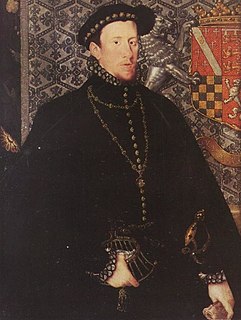
Thomas Howard, 4th Duke of Norfolk, was an English nobleman and politician. Although from a family with strong Catholic leanings, he was raised a Protestant. He was a second cousin of Queen Elizabeth I through her maternal grandmother, and held many high offices during her reign.

Thomas Radclyffe, 3rd Earl of Sussex KG, was Lord Deputy of Ireland during the Tudor period of English history, and a leading courtier during the reign of Elizabeth I.
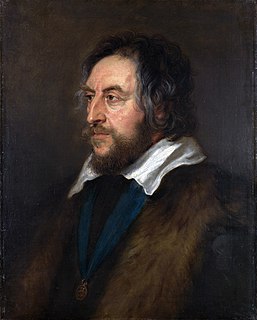
Thomas Howard, 14th Earl of Arundel KG, was a prominent English courtier during the reigns of King James I and King Charles I, but he made his name as a Grand Tourist and art collector rather than as a politician. When he died he possessed 700 paintings, along with large collections of sculpture, books, prints, drawings, and antique jewellery. Most of his collection of marble carvings, known as the Arundel marbles, was eventually left to the University of Oxford.

James Stewart, 1st Earl of Moray, a member of the House of Stewart as the illegitimate son of King James V, was the regent of Scotland for his half-nephew, the infant King James VI, from 1567 until his assassination in 1570. He was the first head of government to be assassinated by a firearm.

Henry Fitzalan, 12th Earl of ArundelKG was an English nobleman, who over his long life assumed a prominent place at the court of all the later Tudor sovereigns, probably the only person to do so.
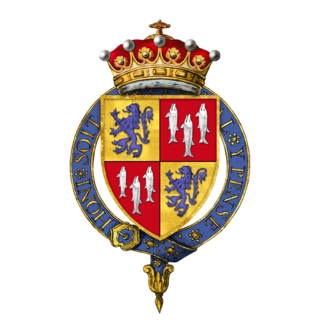
Henry Percy, 4th Earl of NorthumberlandKG was an English aristocrat during the Wars of the Roses. After losing his title when his father was killed fighting the Yorkists, he later regained his position. He led the rear guard of Richard III's army at the Battle of Bosworth, but failed to commit his troops. He was briefly imprisoned by Henry VII, but later restored to his position. A few years later he was murdered by citizens of York during a revolt against Henry VII's taxation.

Ambrose Dudley, 3rd Earl of Warwick, KG was an English nobleman and general, and an elder brother of Queen Elizabeth I's favourite, Robert Dudley, Earl of Leicester. Their father was John Dudley, Duke of Northumberland, who led the English government from 1550–1553 under King Edward VI and unsuccessfully tried to establish Lady Jane Grey on the English throne after the King's death in July 1553. For his participation in this venture Ambrose Dudley was imprisoned in the Tower of London and condemned to death. Reprieved, his rehabilitation came after he fought for King Philip in the Battle of St. Quentin.
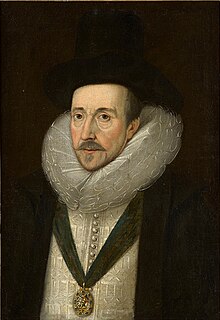
Henry Howard, 1st Earl of Northampton KG was an important English aristocrat and courtier. He was suspect as a crypto-Catholic throughout his life, and went through periods of royal disfavour, in which his reputation suffered greatly. He was distinguished for learning, artistic culture and his public charities. He built Northumberland House in London and superintended the construction of the fine house of Audley End. He founded and planned several hospitals. Francis Bacon included three of his sayings in his Apophthegms, and chose him as "the learnedest councillor in the kingdom to present to the king his Advancement of Learning." After his death, it was discovered that he had been involved in the murder of Sir Thomas Overbury.
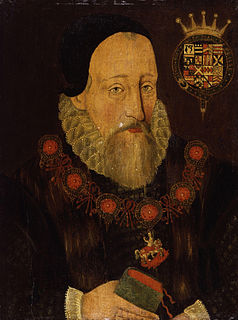
Henry Hastings, 3rd Earl of Huntingdon, KG, KB was an English Puritan nobleman. Educated alongside the future Edward VI, he was briefly imprisoned by Mary I, and later considered by some as a potential successor to Elizabeth I. He hotly opposed the scheme to marry Mary, Queen of Scots, to the Duke of Norfolk, and was entrusted by Elizabeth to see that the Scottish queen did not escape at the time of the threatened uprising in 1569. He served as President of the Council of the North from 1572 until his death in 1595.

Henry Stanley, 4th Earl of Derby KG was a prominent English nobleman, diplomat, and politician. He was an ambassador, Privy Counsellor and participated in the trials of Mary, Queen of Scots and the Earl of Arundel.

George Talbot, 6th Earl of Shrewsbury, 6th Earl of Waterford, 12th Baron Talbot, KG, Earl Marshal was an English magnate and military commander. He also held the subsidiary titles of 15th Baron Strange of Blackmere and 11th Baron Furnivall. He was best known for his tenure as keeper of Mary, Queen of Scots between 1568 – 1585, his marriage to his second wife Elizabeth Talbot, as well as his surviving collection of written work.
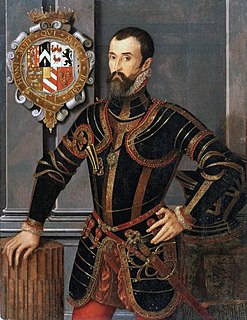
William Herbert, 1st Earl of Pembroke, 1st Baron Herbert of CardiffKG was a Tudor period nobleman, politician, and courtier.
Knollys, Knolles or Knowles, the name of an English family descended from Sir Thomas Knollys, Lord Mayor of London, possibly a kinsman of the celebrated general Sir Robert Knolles. The next distinguished member of the family was Sir Francis Knollys or Knowles, English statesman, son of Sir Robert Knollys, or Knolles, a courtier in the service and favour of Henry VII and Henry VIII. Robert had also a younger son, Sir Henry, who took part in public life during the reign of Elizabeth I and who died in 1583. From the time of Sir Francis, the family were associated with Greys Court at Rotherfield Greys and Caversham Park, then in Oxfordshire, as well as the nearby town of Reading in Berkshire, where the family's private chapel could once be seen in the church of St Laurence.
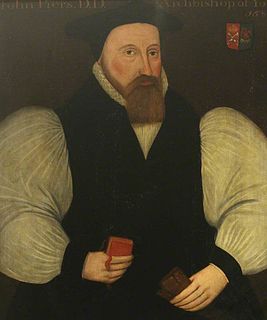
John Piers (Peirse) was Archbishop of York between 1589–1594. Previous to that he had been Bishop of Rochester and Bishop of Salisbury.

Roderigo Lopes served as a physician-in-chief to Queen Elizabeth I of England from 1581 until his death by execution, having been found guilty of plotting to poison her. A Portuguese converso or New Christian of Jewish ancestry, he is the only royal doctor in English history to have been executed, and may have inspired the character of Shylock in Shakespeare's The Merchant of Venice, which was written within four years of his death.

Dorothy Percy, Countess of Northumberland was the younger daughter of Walter Devereux, 1st Earl of Essex by Lettice Knollys, and the wife of Henry Percy, 9th Earl of Northumberland.
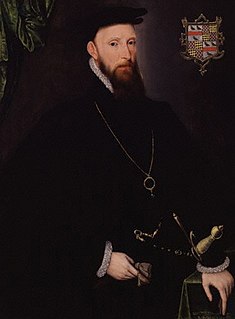
John Lumley, 1st Baron Lumley was an English aristocrat, who is remembered as one of the greatest collectors of art and books of his age.
Anne Percy, Countess of Northumberland was an English noblewoman and one of the instigators of the Northern Rebellion against Queen Elizabeth I of England. To avoid punishment for her prominent role in the failed insurrection, Anne, along with her infant daughter, was forced into exile in Flanders, where she spent the rest of her life involving herself in Catholic plots and maintaining contact with the other English Catholic exiles. In Liège while living on a pension from King Philip II of Spain, she wrote Discours des troubles du Comte du Northumberland. Her husband Thomas Percy, 7th Earl of Northumberland, who had led the rebellion, was executed for treason. Three of her daughters were left behind in England and raised by their paternal uncle, Henry Percy, 8th Earl of Northumberland.

















